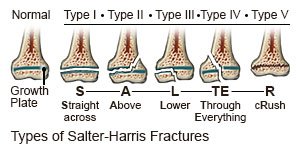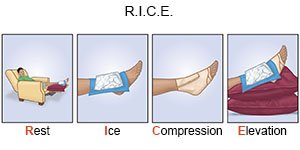Salter-Harris Fracture
Medically reviewed by Drugs.com. Last updated on Aug 4, 2025.
AMBULATORY CARE:
A Salter-Harris fracture
is a break in your child's bone that goes through a growth plate. Growth plates are tissue that forms new bone on the ends of certain bones to make them longer as your child grows. Examples include thigh bones, forearm bones, and finger bones. When your child is finished growing, the growth plates will harden and become solid bone.
Types of Salter-Harris fractures:
 |
- Type 1 fractures are a complete break through the growth plate.
- Type 2 fractures break through the growth plate and crack through part of the bone shaft (long part of the bone).
- Type 3 fractures go through part of the growth plate and crack through part of the bone end.
- Type 4 fractures go through part of the bone shaft, growth plate, and bone end.
- Type 5 fractures occur when the growth plate is crushed.
Common signs and symptoms:
- Pain and swelling
- Tenderness
- A change in the shape of the injured area that is different than usual
- Not being able to move or put weight on the injured arm or leg
Seek care immediately if:
- Your child's pain gets worse, even with medicine.
- The skin under your child's cast or splint is tingling or numb.
- Your child can no longer move his or her fingers or toes.
Call your child's doctor if:
- Your child has a fever.
- Your child says his or her cast or splint feels too tight.
- You see swelling below the splint or cast.
- Your child's cast is cracked or has soft spots.
- You have questions or concerns about your child's condition or care.
Treatment
depends on the type of fracture your child has and how severe it is:
- Prescription pain medicine may be given. Ask your child's healthcare provider how to give this medicine safely. Some prescription pain medicines contain acetaminophen. Do not give your child other medicines that contain acetaminophen without talking to his or her healthcare provider. Too much acetaminophen may cause liver damage. Prescription pain medicine may cause constipation. Ask your child's healthcare provider how to prevent or treat constipation.
- A cast or splint may be used to help prevent movement in the injured area until more treatment is done. If the bone is not displaced (moved out of place), your child may get a cast to secure the bone as it heals. Casts are also used after reduction (when the bone is put back into place) or surgery.
- Surgery may be needed to repair certain types of Salter-Harris fractures. Pins or screws will be placed inside the broken bone. These hold the bone pieces together in the correct places.
Help your child's fracture heal:
 |
- Rest may help your child's fracture heal, and help manage pain. Help your child rest often during the day.
- Elevate the area above the level of your child's heart, as often as possible, for 1 to 3 days. Your child may lie back in a bed or chair and put pillows under an injured leg or foot. Use pillows to prop up the area. Your child should wiggle his or her fingers and toes often to keep blood flowing.
- Ice helps decrease pain and swelling. Put crushed ice in a plastic bag and cover it with a towel. Place the ice over the cast or splint for as long and as often as your child's healthcare provider says you should.
Help prevent sports injuries:
- Take your child for regular checkups as directed. Ask your child to tell you when he or she is hurt. Regular checkups may catch unknown injuries before they get worse.
- Have your child do different exercises. Your child should not do the same exercises or drills every day.
- Teach your child to play safely. Make sure your child competes with other children of the same size, fitness level, and skill.
- Have your child rest during sports activities as directed. Rest periods are needed during sports training. If your child is injured, he or she may need to avoid contact sports for 4 to 6 months to prevent another injury.
Follow up with your child's doctor as directed:
Your child may need to have the fracture checked each week as it heals. Ask how often your child needs to see his or her healthcare provider or bone specialist. Write down your questions so you remember to ask them during your visits.
© Copyright Merative 2025 Information is for End User's use only and may not be sold, redistributed or otherwise used for commercial purposes.
The above information is an educational aid only. It is not intended as medical advice for individual conditions or treatments. Talk to your doctor, nurse or pharmacist before following any medical regimen to see if it is safe and effective for you.
Learn more about Salter-Harris Fracture
Care guides
Further information
Always consult your healthcare provider to ensure the information displayed on this page applies to your personal circumstances.
